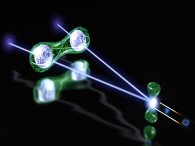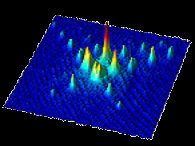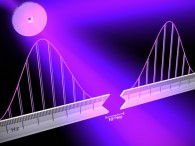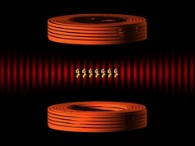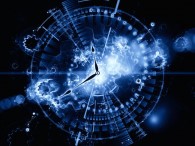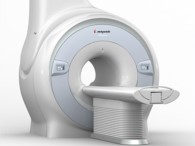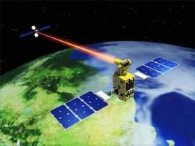
During the past hundred years of development, the theory of quantum physics and the influence of the technology is gradually modern people's life style. Quantum technology mainly includes quantum measurement, quantum communication, quantum secret, sensor, etc., including atomic clock is the main direction of the research of quantum measurement technology. It is local signal source frequency locking in quantum reference system stability on the transition of the resonant frequency, as a kind of high stability and high precision time and frequency measuring equipment, it has been widely used in aerospace, defense, the national standard time, etc. In 1945, Isidor Isaac Rabi puts forward to apply mri bell measurement in [1], from the study of atomic clocks. On the experiment for the first time in 1960, Theodore H.M aiman implements a coherent light source - the stability of laser output, since then, the laser is also used in the study of the atomic clock. Atomic clocks are divided into atomic clocks (hereinafter referred to as microwave clock) of microwave and optical frequency atomic clocks (light), due to the light spectrum than microwave paragraph 4 ~ 5 orders of magnitude higher than that of signal frequency, theoretically proved that light can do that is lower than the microwave clock clock uncertainty [2], now experimental proof is.
So far, there have been dozens of global scientific research institutions and institutions committed to the research work of atomic clocks, basically has the United States in the world of the national institute of standards and technology (NIST), the institute for astrophysics (JILA), Britain's national physical laboratory (NPL), Germany's federal physical technology research institute (PTB), university of western Australia, Australia and so on, the main domestic institute of metrology, tsinghua university, east China normal university, Beijing university, engaged in the research of optical clocks. In 2013, according to reports, NIST realize the uncertainty of the lowest in the world of aluminum ion optical clock, JILA realization of uncertainty in the world in 2014, the lowest strontium atomic optical lattice clocks, uncertainty can be 10 to 18.
Beijing university of information science and technology institute of quantum electronics OFS group (Optical Frequency Standard, OFS), dedicated to the research Yu Guangzhong. Group research directions including small clock (passive), calcium atoms light active optical clock, atomic optical filter, precision laser spectroscopy, laser frequency stabilization technology, etc., covers a number of important scientific significance and use value in this field. After 10 years of efforts, OFS group has made some achievements in the field of optical clock, including:
1. By professor Chen Jingbiao international, first put forward the idea of active optical clock on [3], its theory prove that can realize mHz wide magnitude spectrum lines, combined with the current optical lattice clock light technology, can make its uncertainty to reduce two orders of magnitude. Active optical clock plan proposed by the group are: cesium atomic four-level active optical clock, Faraday optical clock actively, good or bad cavity integration dual wavelength active optical clock. Currently implemented cesium atomic clock four-level active optical clock stimulated emission of radiation signal output.
2. Miniaturization of calcium thermal atomic beam light clock scheme is put forward, and has developed a small beam of light calcium atoms clock prototype machines, successfully closed loop, a second level stability reached 3 * 10-14.
3. Implement the Rb, Ca, Sr Faraday atoms filter [4, 6], and implements the immune to temperature and current of 780 nm Faraday atomic optical filter stabilized laser [5].
Today, OFS group will continue to be committed to Yu Guangzhong research, in the previous achievements on further, but also the new research direction in this field.
Related links:Jun Ye Group, JILA, http://jila.colorado.edu/YeLabs/
NIST, http://www.nist.gov/pml/div688/grp80/index.cfm
Reference:
[1]Isidor I. Rabi, "Radiofrequency spectroscopy" (Richtmyer Memorial Lecture, delivered at Columbia University in New York, New York, on 20 January 1945)
[2] Fritz Riehle, Frequency Standards,9-10,2004
[3]Chen Jingbaio,Active Optical Clock,Chinese Science Bulletin,54,pp.348-352,(2009)
[4]Qinqing Sun,Wei Zhuang,Zhiwen Liu,and Jingbiao Chen,Electrodeless-discharge-vapor-lamp-based faraday anomalous-dispersion optical filter, Optics letters, (2011) Vol.36 No.23:4611-4613
[5]Xinyu Miao, Longfei Yin, Wei Zhuang, Bin Luo, Anhong Dang, Jingbiao Chen, and Hong Guo,Demonstration of an external-cavity diode laser system immune to current and temperature fluctuations,Rev. Sci. Instrum., 82(8), 086106 (20110818).
[6]Qinqing Sun, Yelong Hong, Wei Zhuang, Zhiwen Liu, and Jingbiao Chen,Demonstration of an excited-state Faraday anomalous dispersion optical filter at 1529 nm by use of an electrodeless discharge rubidium vapor lamp, Appl. Phys. Lett. 2012, vol.101, 211102,DOI: 10.1063/1.4767140.

